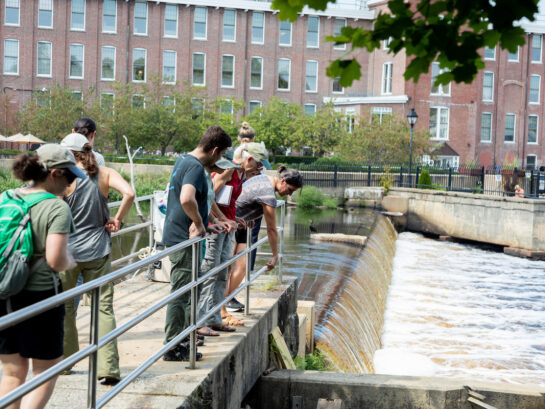IPSWICH MILLS DAM PROJECT
HISTORY
The Ipswich Mills Dam is located in downtown Ipswich. The current dam was built in 1908 to power adjacent mills, and was decommissioned in the 1930s. The dam remained privately owned until the Town of Ipswich bought it from Sylvania Corporation in 1982.
BACKGROUND
This dam is the most impactful dam on the Ipswich River as it is the first you encounter when coming from the sea. Located at the ‘head-of-tide’, this dam represents a hard stop between fresh river water and the saltwater estuary at the river's mouth. It is the first dam encountered by returning migratory fish runs. This 'hard stop' is ecologically destructive because freshwater animals cannot return back to riverine conditions due to the physical barrier of the dam and migratory species do not have the benefit of a gradual change in water chemistry. A fishway was installed in 1995, but even the best fish ladders pose issues for fish. For example, shad will not use ladders at all, herring will use them if conditions are right, and young fish of all species have difficulty navigating them. The Division of Ecological Restoration ranks this dam in the top 5% of all dams in Massachusetts for the restoration potential of removal- it would open 49.19 miles of riverine habitat, restore a freshwater tidal habitat, and remove a head-of-tide dam.

Above: Ecological Management Professionals tour the Ipswich Mills Dam Summer 2023. Photos by Marilyn Humphries.
WHAT ARE THE BENEFITS OF REMOVING THIS DAM?
Bring fish back
The Ipswich Mills Dam is the gateway to the river for all migratory fish species. Dam removal will restore full access to this section of the Ipswich River for a number of migratory fish species, many of which have severely depleted populations. Opening up migratory access past the Ipswich Mills Dam is a critical component of restoring healthier fish runs on the river. Migratory fishes typically begin utilizing upstream habitat soon after dam removal, often in the first year. Access to more spawning and rearing habitat is likely to result in larger populations over a matter of years to decades, as demonstrated by other dam removal projects.
Restore rare habitat
If the dam is removed the tide will extend another 1.5-2 miles upriver. In other words, the river along this stretch will remain fresh but water levels will fluctuate with the tide. A freshwater tidal habitat will be restored to this stretch of the river - the rarest aquatic habitat in Massachusetts!
Improve river health
Removing this dam will restore natural river processes. The dam causes an unnaturally ponded section of the river that drowns the natural river channel. This more stagnant section accumulates sediment, warms the water, and reduces oxygen concentrations during much of the year. Warm water and low oxygen levels are terrible for plants and animals in the river. It also creates water quality conditions that can result in algae blooms making the river unsafe for swimming and other forms of recreation. Further, the dam's location at the head of tide is particularly damaging to the river as it prevents the gradual mixing of salt and freshwater.
Reduce flood risk
Like the vast majority of dams in Massachusetts, the Ipswich Mills Dam provides no flood control benefit. It does however increase flooding somewhat upstream of the dam. To address concerns over flood impacts of dam removal the feasibility study evaluated this and found the following:
Downstream: There will be no change to the amount of water flowing downstream. The Ipswich river Dam is a 'run-of-river' dam, meaning that it does not change the rate of water flowing through the river. The flow of water currently going over the dam will be the same following removal as it is currently.
Upstream: The river’s natural flood storage capacity will be restored. Water levels upstream from the dam will lower, making available additional floodplain storage that can mitigate future flood events. Floodplain storage is one of the best ways to avoid harmful floods during storm events by providing space for the river to expand without impacting infrastructure or buildings.
Increase public safety
The greatest risk to public safety is the risk of dam failure, which would cause downstream flooding if the water impounded behind the dam were released all at once. The risk of catastrophic dam failure only increases with time as the dam ages, especially if maintenance is deferred. Additional public safety risks include the risk of paddlers or swimmers being swept over the dam, which at times would result in a 6-7 foot drop on the downstream side.
Save taxpayer money
As the dam is owned by the town of Ipswich, the town is responsible for all costs associated with it, including inspection and ongoing maintenance of the existing fish ladder. Currently it costs the town on average around $10K per year just for this annual routine maintenance. There are an additional $50K of repairs that are currently needed to address deficiencies. These costs will continue to rise as the dam ages and do not include costs associated with ongoing fishway management, fish counting, and data management that the Town is responsible for but are currently shouldered by IRWA. Although these costs may seem small now, they are a financial burden that the town must continue to bear for a dam that does not provide any benefit to the town. Removing the dam would remove liability, maintenance, and operational costs from the town budget.
Removal of the dam will cost money, but there is NO expectation that the residents of Ipswich will pay for dam removal. An unprecedented amount of federal, state, and private dollars are available specifically for dam removal projects. They are available now and may not be available in the future.
Revive downtown
A restored Ipswich River could be a major economic benefit for the town. Other coastal towns in Massachusetts with restored herring runs have capitalized on this success by hosting popular Herring Festivals, bringing visitors to town during the normally quiet April/May period. Dam removal would also increase recreational opportunities along the stretch of river that runs through downtown Ipswich - without the dam, you could paddle from the Peatfield landing all the way to Crane Beach if you wanted! Finally, the ecological benefits of dam removal would support local fisheries and potentially bring people in pursuit of sport fish including striped bass.
WHAT IS OUR ROLE IN REMOVING THE DAM?
- We are proponents of this project because our mission is to protect and restore the Ipswich River and its watershed, now and for future generations.
- We help the Town of Ipswich get through the complicated process.
- We share and interpret extensive research to the community.
- We secure grants to eliminate taxpayer burden.
PROJECT PARTNERS
Project Team: Town of Ipswich (owner/project lead), Ipswich River Watershed Association, NOAA Restoration Center, MA Division of Ecological Restoration, Horsley Witten Group
Grant Funding: Conservation Law Foundation, NOAA Restoration Center, MA Division of Ecological Restoration, National Fish and Wildlife Foundation
Other Donated Funds and Services: Horsley Witten Group, Clean Soils Environmental, Roux Associates, Biodiversity Consulting, Inter-Fluve, and Alpha Analytical
